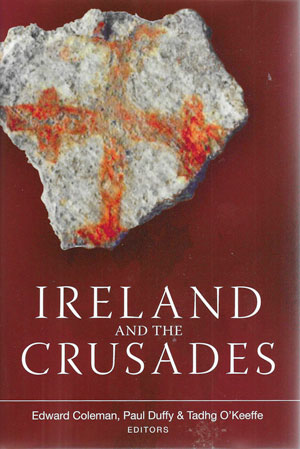IRELAND AND THE CRUSADES
Published in Book Reviews, Book Reviews, Issue 1 (January/February 2023), Reviews, Volume 31EDWARD COLEMAN, PAUL DUFFY and TADHG O’KEEFFE (eds)
Four Courts Press
€44
ISBN 9781846828614
Reviewed by Grace O’Keeffe
Grace O’Keeffe is History Ireland’s online editor.
Edward Coleman opens this volume with a historiographical examination of scholarship on Ireland’s involvement in the crusades, a relatively small field of study. The most obvious reason for this is the survival rate, and location, of source material. One ‘… must search for evidence across the entire corpus of royal administrative documents, ecclesiastical records and narrative sources …’. The launch earlier this year of the Beyond 2022 Virtual Record Treasury of Ireland (beyond2022.ie) will hopefully rectify these lacunae.
The volume in total comprises fourteen essays, including Coleman’s introduction and Tadhg O’Keeffe’s epilogue. O’Keeffe examines Irish crusading through the evidence of building design and archaeological remains. Eastern influences on Irish architecture and geophysical examination of the surviving remains of the buildings of military-religious orders are obvious choices, but other possibilities include crusading souvenirs (the medieval version of the tourist fridge magnet) and burial records.
In considering the impact of St Bernard and the Cistercians on potential Irish crusaders, Jean-Michel Picard first lays out St Bernard’s involvement in preaching for the Second Crusade, which happened to coincide with his period of contact with Malachy, archbishop of Armagh. Picard demonstrates the capacity of the Cistercians to influence opinion in Ireland, through the network of patronage established by both English settler lords and native Irish kings. What is less clear from Picard’s essay is the actual impact of the Cistercian presence in Ireland on recruitment for active involvement in crusading.
Maeve Callan’s essay takes the theme of crusading as religious salvation and applies it to the English invasion of Ireland. The most infamous papal decree purporting to support and encourage the intervention of the English in Ireland is the Laudabiliter, still contentious. As Callan demonstrates, much of the evidence for the utter deprivation of the Irish comes from Gerald of Wales, a useful and entertaining observer of English incursion into Ireland but a wholly compromised chronicler.
The theme of crusading rhetoric in later medieval Anglo-Irish relations is continued by Kathryn Hurlock, who offers a useful exploration of the intensification of religious language in the wake of Henry VIII’s split with Rome. It is perhaps surprising to stop with the Plantation of Ulster and not include the sectarian wars of the 1640s.
The Dublin Guild Merchant Roll (https://databases.dublincity.ie/dmgr/browse.php?image_order=1) was used by Catherine Swift as a basis to examine the reason for the relatively common appearance of ‘Palmer’ as a descriptor. Having written about one of these palmers, Ailred Palmer (http://www.tara.tcd.ie/handle/2262/79292), I would agree with Swift’s suggestion that the number of Palmers in Dublin, men who in theory had successfully completed a long, expensive and arduous journey to the Middle East, were desirable citizens in a city undergoing rapid settlement by English conquerors after colonisation.
Ailred Palmer makes another appearance in Thomas Ivory’s essay on the possible influence of military orders on the medieval hospital in Ireland. As Ivory notes, medieval hospitals were in fact much more than hospitals, though many offered no medical care beyond what could be cultivated in their garden. Many of these hospitals in Ireland were part of a wave of similar institutions being founded in the late twelfth century. The founders of other fratres cruciferi hospitals (Ardee, Drogheda) were in the same social milieu, and the hospital in Nenagh might even have taken brethren from the Dublin house.
Within this circle of society (de Lacy, Pipard) there were many motivations for patronising religious houses of all kinds. Helen J. Nicholson examines donations by magnate families to the military orders in Ireland, focusing particularly on the purpose of their generosity. Patronage brought both religious and secular benefits. It also made many of these houses extremely wealthy and influential. Paolo Virtuani provides a brief but very clear examination of the Irish Hospitallers, using the evidence of disputes involving their priors.
By highlighting the involvement of Hugh de Lacy II in the Cathar Crusade, Paul Duffy very deftly demonstrates, with tangible evidence, how the English colony in Ireland was affected by events abroad. Ciarán McDonnell’s essay takes up this research mantle by exploring the crusading experience of Geoffrey de Geneville, perhaps known best for his position as justiciar of Ireland in the late twelfth century. The reconstruction of the manor of Ballyman by David McIlreavy is a wonderful example of a ‘how-to’ when piecing together a variety of documentary and archaeological sources to present new interpretations.
Effigy tombs are a distinctive, and visual, route to uncovering history. Dave Swift’s essay questioning the validity of a ‘cross-legged’ effigy representing crusaders and Emer Purcell’s paper on Ireland’s most famous crusader, the St Michan’s mummy, complement each other well. Both do a fantastic job of myth-busting.
This is a collection of somewhat uneven scholarship; some papers are gripping and deeply researched, while others are a little too scant in their offerings. The still-unanswered question is what the Irish did while on crusade, a question difficult to answer (and requiring access to Middle Eastern sources), and one that might be unpalatable to many. Even where the crusading link might seem tenuous, all essays offer points of interest, enough to make this volume an essential addition to the medievalist’s bookshelf.

















